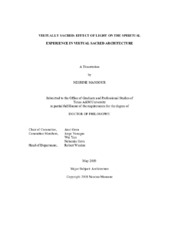| dc.description.abstract | As the use of digital technology became a substantial component of our daily life activities, people grew less dependent on the constraints of the physical world. Recent developments of new media platforms have led to the creation of virtual spaces introducing important changes in the practice of religion resulting in the phenomenon of digital religion. There is suggestive evidence that virtual representations of religious buildings facilitate a spiritual experience similar to the experience in real houses of worship. Some features related to sacred architecture, light for instance, can influence the spatial perception and spiritual experience. Literature shows that light can uplift the worshipers’ soul and contribute in enhancing spirituality. Yet, there is no empirical research on the effect of light in virtual sacred architecture on spirituality. Thus, the objective of this study is to empirically assess the effect of light on the spiritual experience as an emotional response in virtual sacred architecture.
In pursuing this objective, two conceptual models were developed to illustrate the inter-relationship among three major elements: (a) faith/religion, (b) light/virtual sacred architecture, and (c) digital media. The three intersect and create the spiritual experience.
The study utilizes an experimental approach composed of a virtual walkthrough within a digital church followed by a questionnaire that tests the emotional responses (e.g., spiritual feeling, positive/negative emotions) of the participants. Four manipulations of the virtual space were carried in two experiments: light intensity, light source, church architecture, and religious iconography. A crowdsourcing website, Amazon Mechanical Turk (MTurk), was used to conduct these experiments.
The results support the research main hypotheses that light and its attributes (e.g., intensity and source) have an effect on the spiritual experience in virtual sacred architecture. The findings also add information to the design strategies of virtual sacred environments.
The dissertation’s conclusion shows that this study bridges different disciplines, such as architecture, digital humanities, and social sciences in creating a platform for empirical exploration of the virtual ‘built’ environment. It also includes suggestions for further research such as the implementation of lighting design guidelines for virtual sacred architecture that can also apply to real sacred architecture. Furthermore, this research can expand to other religious buildings and faiths providing a whole new way of looking at sacred architecture with a virtual eye. | en |


